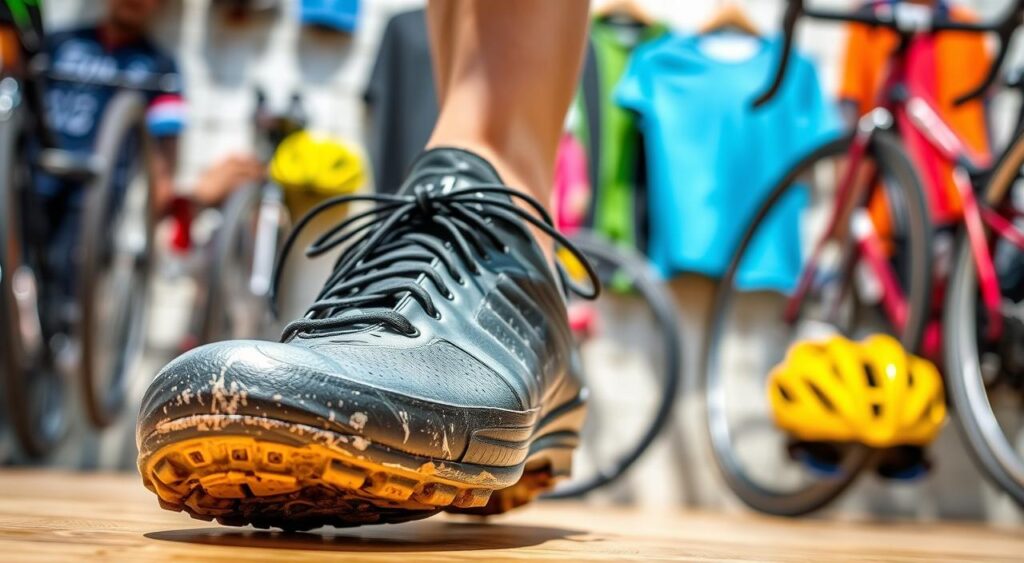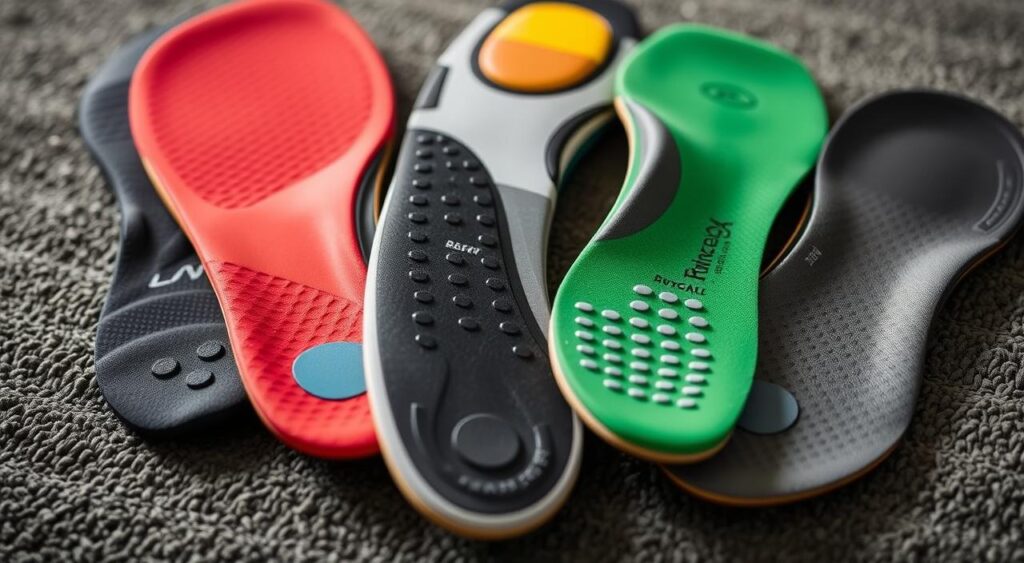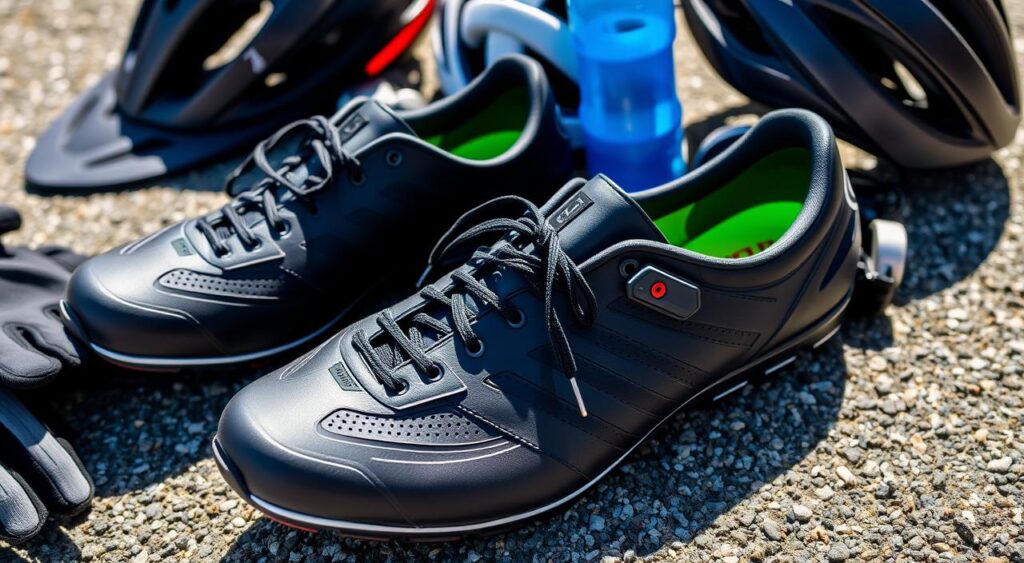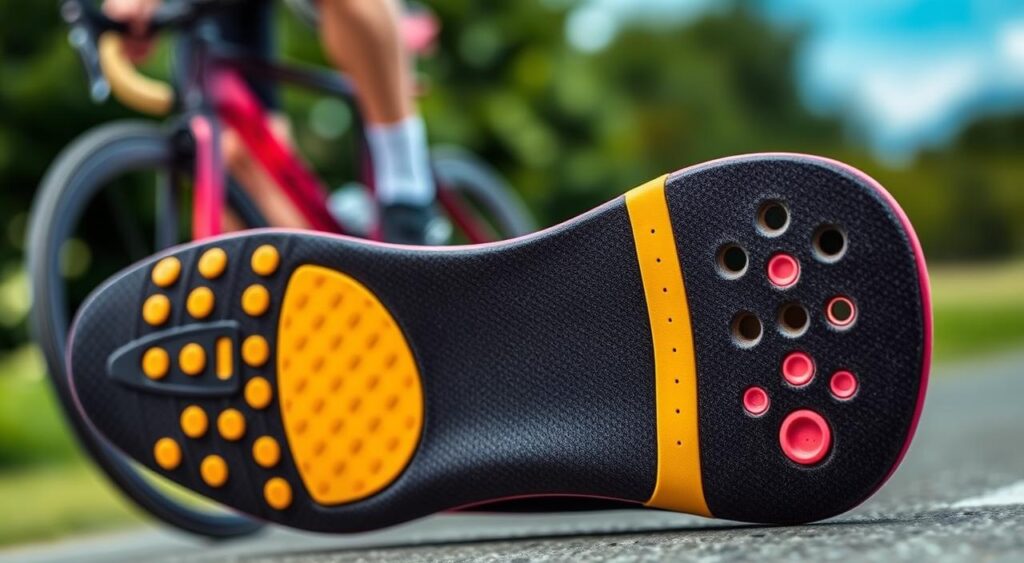Every cyclist has wondered when to replace their shoes. It might seem simple, but if money is tight, you might try to stretch their life. Yet, your safety and comfort are key. Experts say it’s time for new shoes when they show a lot of wear, like broken soles or torn uppers.
It’s also important to swap out the insoles to keep your feet supported and cushioned.
Table of Contents
Signs It’s Time to Replace Insoles
Keeping your cycling shoes well-cushioned and supported is key for comfort and performance. Over time, insoles can wear out, causing problems. Here are signs it’s time for new insoles:
Visible Wear and Tear
Check your insoles for cracks, tears, or compressed spots. If you see these, the insoles are damaged. This can make your rides less comfortable.
Reduced Cushioning
Feeling the hard shoe sole through the insole means cushioning is gone. This can make your feet tired, especially on long rides.
Increased Foot Pain
New or worse foot pain while cycling might mean your insoles need a change. Replacing them can help ease the pain.
Unpleasant Odors
Sweat and bacteria can make your insoles smell bad over time. Even with cleaning, bad smells mean it’s time for new insoles.
Watching for these signs helps you know when to get new insoles. This keeps your feet comfy and supported on your rides.
Consequences of Not Replacing Worn Insoles

Cycling fans often forget to replace their cycling shoes’ insoles. But, not doing so can cause many problems. These problems might impair your health and make riding less enjoyable.
Without good cushioning and support, your feet can hurt. This pain can spread to your knees, hips, and back. Worn-out insoles also raise the chance of getting hurt while cycling, like plantar fasciitis or ankle sprains.
Also, when insoles wear out, your cycling shoes have to work harder. This extra effort can make your shoes wear down faster. You’ll need to replace them more often.
Custom orthotics can help avoid these problems. They fit your foot perfectly, supporting it well. This can prevent foot pain and injuries.
Start using custom orthotics slowly, wearing them for an hour a day. Gradually increase the time over 2-4 weeks. This lets your body get used to them. Even though they cost more, they offer long-lasting comfort and support for cycling.
| Consequence | Impact |
|---|---|
| Foot Pain | Can lead to misalignment and discomfort in knees, hips, and back |
| Increased Injury Risk | Higher likelihood of conditions like plantar fasciitis and ankle sprains |
| Reduced Shoe Lifespan | Shoes have to work harder, causing them to wear out more quickly |
To keep your cycling skills sharp and stay healthy, replace your insoles often. Think about getting custom orthotics made just for you. Taking care of your cycling shoes can make your rides more enjoyable and safe.
Lifespan of Insoles by Material

The life of your cycling shoe insoles depends on their material. Knowing how long different insoles last helps you keep your gear in top shape. This ensures you stay comfortable and perform well on your bike.
Foam Insoles
Foam insoles, like memory foam and polyurethane foam, don’t last long. They can last from 6 months to 2 years, depending on quality and how much you cycle. Memory foam insoles lose shape faster, but polyurethane and plastazote foam last longer.
Gel Insoles
Gel insoles are great for shock absorption and comfort. But, they don’t last long, lasting 1 to 2 months. The gel material breaks down quickly from cycling stress.
Cork Insoles
Cork insoles last longer, up to 12 to 24 months with good care. Cork’s natural support and cushioning make it a favorite for cyclists looking for durability.
Leather Insoles
Leather insoles are very durable, lasting up to 2 years with proper care. Leather’s natural flexibility and breathability make it a top choice for cycling shoes. It offers long-lasting comfort and support.
The actual life of your insoles depends on your cycling habits and how you care for your gear. Regular checks and timely replacements keep your feet comfortable and supported on rides.
Benefits of Changing Insoles Regularly

Replacing your cycling shoe insoles often can greatly improve your ride. New insoles provide better cushioning and support. This makes your rides more comfortable and reduces foot pain.
They also help keep your body aligned right. This lowers the chance of pain in your knees, hips, and back.
Switching insoles can also make your shoes last longer. They don’t have to work as hard to cushion and support your feet. Plus, new insoles are good for your foot health. They prevent problems like plantar fasciitis, blisters, and fungal infections.
- Improved cushioning and support for greater comfort
- Proper body alignment to reduce pain in knees, hips, and back
- Prolonged shoe lifespan by reducing the strain on the shoe’s materials
- Prevention of foot-related issues like plantar fasciitis and blisters
Custom sports orthotics are also great for cyclists. They help reduce discomfort from hard exercise, ease pressure points, and spread weight evenly. Materials like silicone gel or EVA foam in orthotics absorb shock and lessen joint impact during cycling.
“Regularly changing your cycling shoe insoles can make a significant difference in your overall comfort and performance on the bike.”
By focusing on your feet’ health and support, you can boost your cycling experience. Don’t overlook the importance of well-kept insoles for a better cycling journey.
How Often Do People Replace Insoles?

The time it takes to replace bike shoe insoles varies. It depends on how often you ride and how active you are. For casual riders, it’s best to swap them out every 6-12 months. But, if you ride a lot or do sports that are hard on your feet, you might need to change them every 3-6 months.
People who wear work boots or stand a lot should also think about replacing insoles. Doing so every 3-6 months keeps your cycling shoes comfy and performing well. This can prevent foot pain, tiredness, and even injuries.
| Insole Replacement Frequency | Cycling Activity Level |
|---|---|
| Every 6-12 months | Casual, everyday cycling |
| Every 3-6 months | Intensive cycling or high-impact sports |
| Every 3-6 months | Wearing work boots or long shifts on feet |
Watch for signs that your insoles need a change. Look for wear, less cushioning, foot pain, and bad smells. Replacing them regularly keeps your cycling gear comfy and safe, making your rides better.
Remember, the type of insole affects how long it lasts. Foam insoles might last 6-12 months, while memory foam or gel can go up to 18 months with good care. Choosing durable, quality insoles means they’ll last longer and keep your feet happy while cycling.
Importance of Proper Cycling Footwear
Choosing the right cycling footwear is key for better performance, comfort, and safety. Cycling shoes help you pedal better and avoid injuries. Wearing the wrong shoes can cause foot pain and slipping during hard pedaling.
Quality cycling shoes with stiff soles and secure closures make a big difference. They improve your cycling experience and help you enjoy your workouts more. The right shoes can make your cycling more efficient and fun.
| Shoe Model | Mileage | Key Features |
|---|---|---|
| Shimano Mountain Bike Cleats | 7,000 miles | Durable for long-distance touring |
| Shimano RP2W SPD-SL Women’s Shoes | Covered first half of cycling journey | Reliable for long-distance cycling |
| Giro Carbide R SPD Shoe | Used for a cycling tour from Vietnam to the UK | Suitable for long-distance cycling trips |
| BBB Hardware Overshoes | N/A | Ideal for rainy and cold cycling conditions |
For longer cycling tours, carry two pairs of cycling shoes. One for biking and another for off-bike comfort, like trainers or hiking sandals. This ensures you stay comfortable and versatile on your journey.
When picking cycle touring shoes, think about weight, comfort, and closure. Also, decide if you prefer clips or flat shoes based on your needs and preferences. The right shoes can greatly enhance your pedaling efficiency and overall cycling joy.
Cycling
Cycling is a popular way to stay fit. It’s a high-intensity, low-impact workout that strengthens your heart and tones muscles. You can choose from road bikes, mountain bikes, or indoor cycling. The right gear can greatly improve your performance and enjoyment.
Cycling shoes are a key piece of equipment. They help you transfer power better, grip the pedals, and feel comfortable. Good cycling shoes make your workouts more effective and fun.
The Importance of Cycling Shoes
Cycling shoes have features that regular shoes don’t. They have a stiff sole that helps you push power to the pedals. This lets you pedal more efficiently. They also have a special cleat that clips into the pedal, helping you pull up and push down.
Getting the right cycling shoes can really boost your performance. Studies show they can increase power output by 2-3% compared to regular shoes.
Choosing the Right Cycling Shoes
When picking cycling shoes, think about your type of cycling, fit, and features. Road cycling shoes are lighter and more aerodynamic. Mountain bike shoes are tougher and have better tread for off-road riding.
Finding the right fit is key. Try on shoes with the socks you’ll wear. They should fit snugly but not too tight.
Caring for Your Cycling Shoes
To keep your cycling shoes in top shape, clean them regularly, replace worn cleats, and store them in a cool, dry place. Proper care ensures they support and transfer power well, making your rides enjoyable and effective.
Whether you’re new to cycling or an experienced rider, the right shoes are crucial. They help you get the most out of your workouts and enjoy the sport more.
Key Features of Cycling Shoes
When picking cycling shoes, think about fit and comfort first. Shoes that are too tight can cause blisters and cramps. Shoes that are too loose might make pedaling less efficient.
Breathability and durability are also key. Indoor cycling can get sweaty, and your shoes need to handle intense workouts well.
The weight and performance of the shoes matter too. Lighter, stiffer shoes help you pedal more efficiently. Road cycling shoes usually have stiff soles for better efficiency and often lack rubberized soles for more stability.
Mountain bike shoes have grippy soles for better traction on trails. They come in clipless and flat pedal versions. Road bike shoes often have a 3-hole cleat system for better stability and energy transfer.
Stiff soles and light materials like carbon fiber in road cycling shoes can improve performance. However, they might cost more. Clipless mountain bike shoes use a two-bolt cleat system for easier walking.
Mountain bike shoes with flat pedals are great for trail riding. They have wide platforms with grippy rubber soles. Cycling shoes should fit snugly but not too tight to avoid discomfort.
| Cycling Shoe Type | Key Features |
|---|---|
| Road Cycling Shoes | Stiff soles for optimal efficiency, minimal rubberized soles for stability |
| Mountain Bike Shoes | Grippy soles for traction, available in clipless and flat pedal versions |
| Road Bike Shoes | 3-hole cleat system for enhanced stability and energy transfer |
| Clipless Mountain Bike Shoes | Two-bolt cleat system (SPD, crankbrothers, Time) for easy walking |
| Mountain Bike Shoes with Flat Pedals | Wider platforms with grippy rubber outsoles for trail riding |
Road bike shoes aim to transfer power to the pedal efficiently and are light. They often use materials like carbon fiber for stiffness and lightness. Cross-country mountain bike shoes have stiff soles for racing, while enduro shoes focus on comfort and grip.
Gravel shoes combine road bike and mountain bike features. They offer efficient power transfer, durability, and comfort for off-road adventures. Touring shoes have slightly flexible soles for comfort when walking during bike tours.
BMX and dirt bike shoes are more robust and flexible than mountain bike shoes. They offer increased grip, protection, and stability for various terrains. Spin shoes are designed for indoor cycling, enhancing cardio training with specific features for spin bikes.
Conclusion
Keeping your cycling shoes in top shape is key for a great biking experience. Knowing when to replace your insoles helps keep your feet comfy and pain-free. This is crucial for every cycling ride.
This guide has shown you how to spot when it’s time for new insoles. It also highlights the benefits of doing so. Whether you’re into road bikes or mountain bikes, good cycling gear and care can boost your biking fun and skill.
Don’t forget, taking care of your cycling shoes is part of bigger bike maintenance. Knowing about cycling routes, cycling events, and bike safety can make your rides even better. It’s a step towards a lifetime of fun and healthy cycling.
| Key Takeaways |
|---|
| – Regularly replace cycling shoe insoles for comfort and performance |
| – Be aware of the signs it’s time for new insoles, like visible wear and increased foot pain |
| – Understand the lifespan of different insole materials to guide your replacement schedule |
| – Invest in quality cycling footwear and maintain it properly for optimal results |
“Cycling is not just a sport, it’s a way of life. Taking care of your gear is essential for enjoying the journey.”
Types of Indoor Cycling Shoes
Having the right shoes for cycling can really improve your performance and comfort. Indoor cycling shoes are made to support, stabilize, and transfer power for stationary bike workouts. They come in different types, each suited for specific cycling needs and preferences.
Clip-In vs. Clip-On Cycling Shoes
Indoor cycling shoes differ mainly in how they attach to pedals. Clip-in shoes have cleats that fit directly into the pedals, offering a secure and efficient connection. This is best for serious cyclists who want a powerful and controlled pedal stroke. Clip-on shoes, however, work with standard pedals or straps. They’re great for casual riders who like the flexibility to use regular pedals.
Road Cycling Shoes vs. Mountain Bike Shoes
Indoor cycling shoes also vary based on the terrain they’re designed for. Road cycling shoes are made for smooth surfaces and high speeds. They’re sleek and lightweight, focusing on efficiency. Mountain bike shoes offer more grip and versatility, ideal for off-road riding. For indoor cycling, shoes that blend the best of both road and mountain bike shoes are often suggested.
SPD Cycling Shoes and Compatibility
When choosing indoor cycling shoes, compatibility with pedals is key. SPD (Shimano Pedaling Dynamics) cycling shoes are popular because they fit many indoor cycling bikes and trainers. This makes them versatile for both indoor and outdoor cycling activities.
Buying and Maintaining Cycling Shoes
Where to Buy Indoor Cycling Shoes
Looking for indoor cycling shoes? You have many options. For those new or on a budget, Tiem and Venzo offer affordable choices. Serious cyclists might prefer Shimano, Specialized, Sidi, or Fizik for their advanced features.
Caring for Your Cycling Shoes
Proper care can make your cycling shoes last longer. After each ride, clean them and let them dry. Check the cleats often and replace them when needed for a good pedal connection.
Looking after your cycling gear, like shoes, is key for better performance and safety. It also makes cycling more enjoyable. Whether you’re a seasoned rider or just starting, taking care of your equipment is crucial.
FAQ
How often should you replace cycling shoes insoles?
Many cyclists wonder when to replace their shoe insoles. It’s not just about saving money. Your safety and comfort are key. Experts say to replace them when you see a lot of wear, like broken parts or damage to the upper.
Also, don’t forget about the insoles. They help support and cushion your feet.
What are the signs it’s time to replace cycling shoe insoles?
Look out for signs like visible wear, less cushioning, foot pain, and bad smells. Cracks, tears, or compressed areas mean the insoles are worn out. If you feel the hard sole, it’s time for new ones.
Foot pain, especially in the arches or heels, is another sign. And if your insoles smell bad and won’t go away, it’s time for a change.
What are the consequences of not replacing worn-out insoles?
Not replacing insoles can lead to foot pain, back and joint pain, and a higher risk of injury. Without support, your feet may hurt, leading to pain in your knees, hips, and back. Worn-out insoles also make your shoes wear out faster.
What is the lifespan of different cycling shoe insole materials?
The life of cycling shoe insoles varies by material. Foam insoles, like memory foam, last 6 months to 2 years. Gel insoles last 1-2 months. Cork insoles can last 12-24 months with care. Leather insoles are the longest-lasting, up to 2 years.
What are the benefits of changing cycling shoe insoles regularly?
New insoles mean better cushioning and support, making your rides more comfortable. They also help prevent foot pain and keep your body aligned right. Plus, they can make your shoes last longer and keep your feet healthy.
How often do people replace their cycling shoe insoles?
How often you replace insoles depends on how much you ride. Casual riders might replace them every 6-12 months. Athletes or those who ride a lot should do it every 3-6 months. People who wear work boots a lot should also replace them often.
Why is proper cycling footwear important?
The right shoes improve your ride, comfort, and safety. They help you pedal better and reduce injury risk. Bad shoes can cause foot pain and slipping. Good shoes make your rides better and safer.
Why are indoor cycling shoes important?
Indoor cycling is a great workout that’s low-impact and high-energy. The right shoes are key for a good workout. They help you pedal better and perform better.
What are the key features to consider when selecting cycling shoes?
Look for shoes that fit well and are comfortable. They should be breathable and durable for sweaty workouts. Lighter, stiffer shoes are better for power and efficiency.
What are the different types of indoor cycling shoes?
There are many types of shoes for different needs. Clip-in shoes are for serious riders, while clip-on shoes are for casual use. Road shoes are for speed, and mountain bike shoes are for off-road. Spin shoes are a mix for indoor riding.
Where can I buy indoor cycling shoes, and how should I care for them?
You can find indoor cycling shoes online or in stores. Affordable options are good for beginners or those on a budget. High-end shoes offer advanced features. Always clean and dry your shoes and check the cleats regularly. This care will make your shoes last longer and keep you comfortable.
